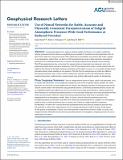Use of neural networks for stable, accurate and physically consistent parameterization of subgrid atmospheric processes with good performance at reduced precision
Author(s)
Yuval, Janni; O'Gorman, Paul A; Hill, Chris N
DownloadPublished version (412.6Kb)
Publisher with Creative Commons License
Publisher with Creative Commons License
Creative Commons Attribution
Terms of use
Metadata
Show full item recordAbstract
A promising approach to improve climate-model simulations is to replace
traditional subgrid parameterizations based on simplified physical models by
machine learning algorithms that are data-driven. However, neural networks
(NNs) often lead to instabilities and climate drift when coupled to an
atmospheric model. Here we learn an NN parameterization from a high-resolution
atmospheric simulation in an idealized domain by coarse graining the model
equations and output. The NN parameterization has a structure that ensures
physical constraints are respected, and it leads to stable simulations that
replicate the climate of the high-resolution simulation with similar accuracy
to a successful random-forest parameterization while needing far less memory.
We find that the simulations are stable for a variety of NN architectures and
horizontal resolutions, and that an NN with substantially reduced numerical
precision could decrease computational costs without affecting the quality of
simulations.
Date issued
2021Department
Massachusetts Institute of Technology. Department of Earth, Atmospheric, and Planetary SciencesJournal
Geophysical Research Letters
Publisher
American Geophysical Union (AGU)